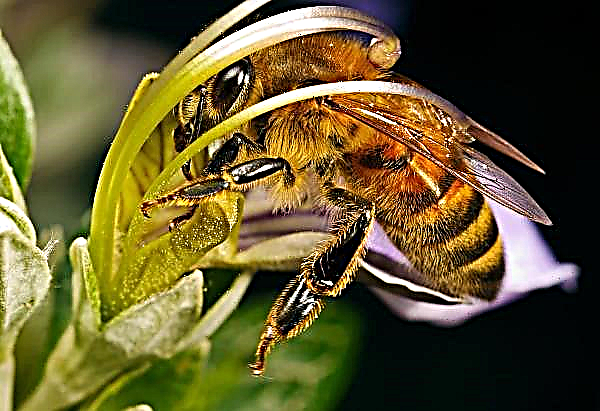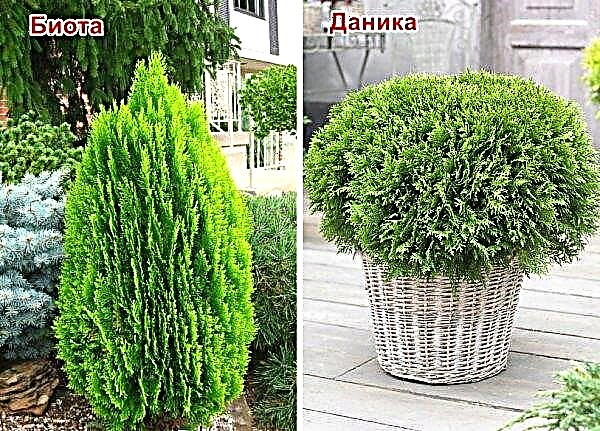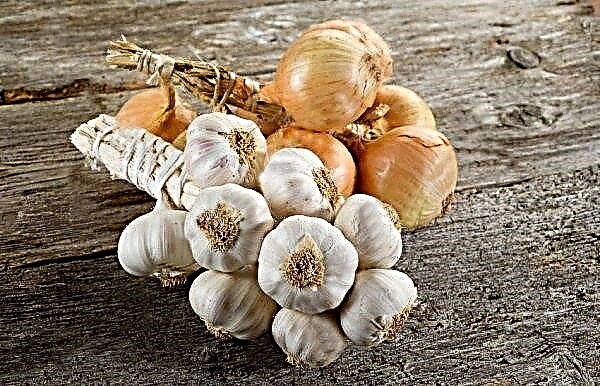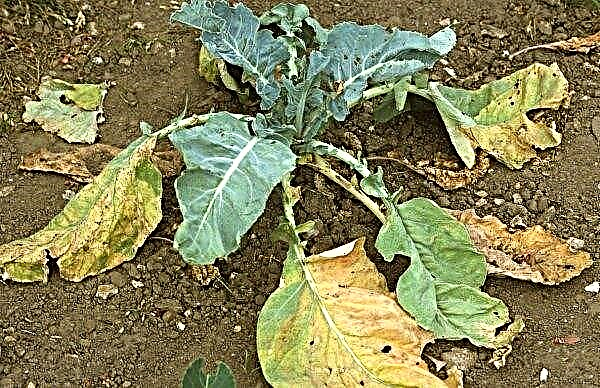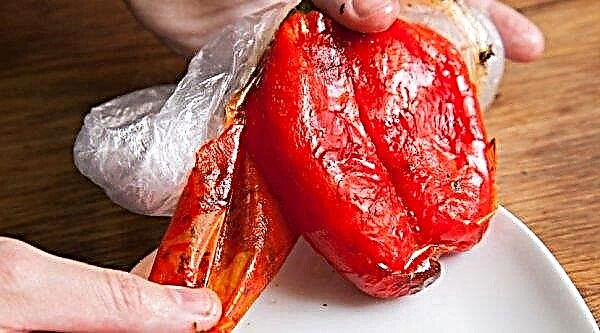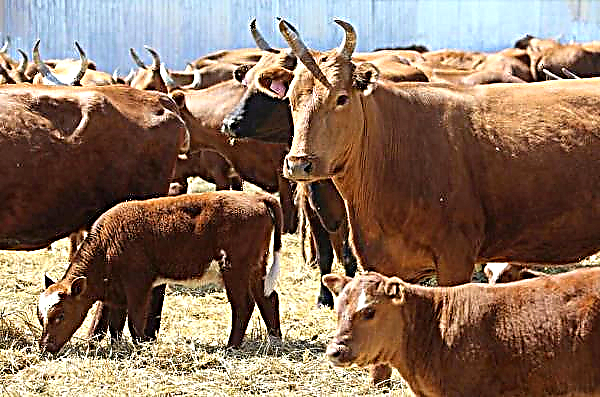Red onion is an excellent substitute for a standard vegetable, due to its attractive bright color, which can complement any dish. What is even more remarkable about this variety, is it possible to plant it in the middle zone, and what varieties are worth paying attention to - you will learn about this from the article below.
Description and composition
Red onion is a variety of onions, the main difference is the red-violet color. The pulp of a colored bulb is more white, but with shades of purple around the edges. The fruits are medium-sized, soft and delicate in taste. The bitterness characteristic of onions is absent in them, and instead of it, sweetness is felt (its severity depends on the variety). The aerial part of the red variety is practically indistinguishable from other variants of a particular botanical species: multilayer leaves can grow up to 1 m in height. Thin membranes between them differ in a characteristic red-violet color, but the juicy part is not so brightly colored.
Almost all varieties of red onions that exist today have a common origin and, according to botanists, have spread from the territory of Central Asia. A little later, thanks to the staff of the Nikitsky Botanical Garden (Crimea), the collection of such plants was replenished with new delicious specimens of red onion.

Varieties from the island of Madeira (Spain), which also differed in increased sweetness, are considered the ancestors of modern Crimean onions. Other varieties grown on the Eurasian continent are characterized by a mixed taste, combining sweetness and bitterness, more characteristic of white and yellow onions.
In addition to the color and pleasant taste characteristics, it is worth noting the high benefit of the red variety, due to its richer composition. So, a red vegetable contains B vitamins (B1, B2, B5, B6), as well as useful substances, among which iron and iodine stand out.
Did you know? India ranks first in the export of red onions in the world (more than 700 thousand tons annually), and the leader in imports — Russia, where every citizen annually eats at least 10 kg of bulbs.
Varieties of Red Onion
On the territory of the middle climatic zone, which unites most of Russia and Ukraine, different varieties of red onions are grown, but they are more common than others:
- Yalta (aka Crimean). It is characterized by a red color, elegant shape (the bulb is low and wide, it seems a bit flattened) and incredible sweetness. Due to the juicy pulp it is often used in the preparation of salads and other dishes from fresh ingredients.

- Crimson Ball - early ripe, the fruits of which can be collected already 85–90 days after sowing seeds. Dark purple bulbs of regular round shape, distinguished by juiciness and pleasant taste. Sweetness is not as high as in the previous version. It bears fruit throughout the season, bringing a stable crop of healthy vegetables, and fresh onions are more suitable for eating.

- Greatfall Red F1 - a high-yielding hybrid variety of medium-term ripening (the crop can be harvested about 120 days after sowing). The color of large and equally sized bulbs is dark red. The main difference from the other varieties is a high level of fruit keeping quality, which makes onions suitable for long-term transportation and can be stored for a long time.

- Campillo F1 - A unique hybrid variety characterized by round and dense bulbs of a delicate purple hue. When slicing, they can stain everything around, but the taste of the fruits is soft, so even children love them. Additional benefits include increased resistance to pink rot and fusarium, which often affects onion plantations.

- Yukont- a red variety of early ripening for one-year cultivation. The shape of the fruit is flat-rounded, the color is saturated, red, with clearly visible violet outlines. This onion will delight gardeners with increased productivity, because from 1 m² you can collect about 3 kg of juicy and relatively sharp bulbs. The variety has good keeping quality, so the bulbs can be stored until spring.
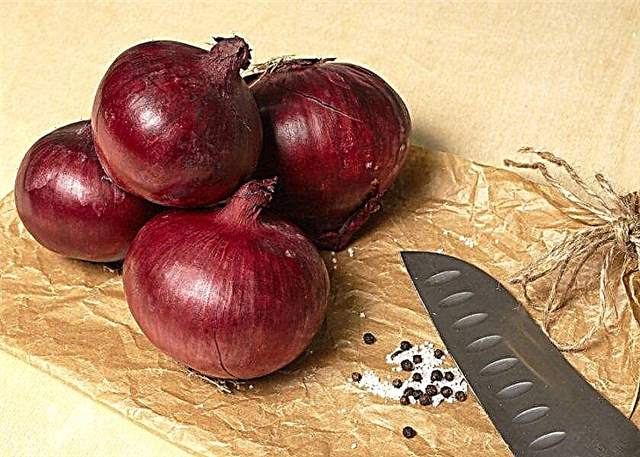
- Retro - a high-yielding variety of early ripening (you can try the bulbs 80–90 days after planting the seeds in the ground). Like the Campillo variety, the flakes of this vegetable have a rich dark red color, and the juicier flesh is always white. The vegetable tastes sweet, and it can be used in cooking children's dishes, although more often salads and other fresh dishes are prepared with his participation.

Calorie content and mineral composition
Red onion is a low-calorie product, since there are only 40 kcal per 100 g of pulp. However, this does not make it less useful, on the contrary, the rich mineral composition only expands the list of its beneficial properties.
In addition to the above iodine and iron, the vegetable contains:Important! Many varieties with purple bulbs are also classified as red onions, despite color mismatches.
- fiber;
- cobalt;
- boron;
- chromium;
- fluorine;
- sulfur;
- phosphorus;
- chlorine;
- potassium;
- calcium;
- sodium;
- magnesium.
These are almost all the mineral compounds that the human body needs, so do not be surprised that red onions can heal a person from many ailments.
Useful properties and contraindications
- Onion is not a panacea for serious diseases, but at the same time it has a wide range of useful properties, which include the following:
- antiseptic (especially with sore throats, colds, SARS);
- strengthening the heart muscle and heart as a whole by lowering the level of cholesterol in the blood (with daily onion consumption after 1.5 months, the cholesterol content in the body is reduced by 20-25%);
- leaching of pathogens from the eyes and nose when slicing onions (sulfur compounds present in the fruits, after mixing with air, irritate the eye mucosa and wash microbes together with tears, preventing their reproduction);
- acceleration of metabolic processes in the body (due to belonging to ergotropic products that can act on the hypothalamus and increase energy consumption, due to which it is possible to achieve weight loss);
- strengthening the body's immune forces, separation and elimination of sputum during coughing, colds or bronchitis;
- digestion stimulation;
- normalization of blood pressure;
- removal of salt deposits from the body;
- the fight against bleeding gums with periodontal disease;
- relieving headaches;
- stimulation of sexual function in men;
- increased hair growth intensity, treatment of acne rashes, increased skin elasticity.

The negative effect of red onion on the body is possible only if a person is diagnosed with serious problems with the liver, kidneys or gastrointestinal tract. However, even if they are not there, you should not exceed the recommended norm and eat more than 100-150 g of onion per day. Do not abuse the product and individuals suffering from nervous disorders or increased excitability so as not to further aggravate their condition.
Important! To reduce the possibility of the negative effects of red onion on the human body, before using it, it is worth pouring boiled water over the pulp, having previously cut it into thin rings. Thus, you will save most of the useful components and get rid of bitterness.
Ways to use red onion
Any kind of this vegetable is mainly used only in cooking, however, if you are a supporter of alternative methods of treatment, then you will probably be interested to know about the ways of using the red variety in recipes of traditional medicine. Consider the features of the application of the described vegetable in each case.
Video: Properties of Red Onion
In folk medicine
The use of onions in folk medicine is more often comparable to the treatment of colds, hemorrhoids, the elimination of worms and the normalization of the menstrual cycle in women.
For rhinitis and SARS, especially if the course of the disease is accompanied by a cough, it is useful to use a mixture of onion juice and goose fat (can be replaced with honey), combined in a 1: 1 ratio. The finished composition should be rubbed into the chest before bedtime, immediately wrapping yourself in a warm blanket. If there is no cough, but there are other signs of a cold (for example, runny nose, nasal congestion and soreness in the throat), the composition for internal use can be prepared from the juice of the bulb, after mixing equal proportions of the juice and honey (use the prepared mixture 1 tablespoon 4 times in day).
To cope with a runny nose, tampons inserted in the nostrils soaked in a mixture of onion juice, honey, milk and alcohol help, but this treatment should be discussed with your doctor in advance (for any problems in the structure of the nose, you can only aggravate the condition).
In the fight against parasites, an infusion of 1 cup of warm water and one onion is useful: pour the vegetable with liquid and insist for seven hours, after which take 0.5 cup on an empty stomach. The course of treatment is 4–5 days.
In the treatment of hemorrhoids, a mixture of onion juice with honey (in equal proportions) is appropriate, which is taken in 1 tbsp. spoon at least four times a day, always before the main meal.
If the menstrual cycle is violated, it is not pulp that is used, but red onion husk (1 kg is enough), and for the preparation of a medicinal purification drug, pour two glasses of boiling water and boil over low heat for 20 minutes. After the mixture has completely cooled, it is filtered and 0.5 cups are drunk every morning for the next two weeks.
Also, do not forget that the red vegetable contains a considerable amount of vitamin C, which means it is useful for the prevention of inflammatory processes in the gums or the prevention of viral and colds.
Did you know? Experts recommend eating onions to stewardesses and pilots, which is associated with the vegetable's ability to simplify the adaptation of the human body to different time zones.
In cooking
For culinary purposes, red onion (no matter what it is called) is used in the same way as onions, which means that it can be included in dishes fresh and cooked, pickling, baking, frying. In addition, it is combined with stewed or grilled products, and with the right variety and the requirements for agricultural cultivation, red onions can add them a pleasant sweetness. The presence of vegetables is appropriate in the first and second courses, salads, and in some cases also in desserts, not to mention the improvement in the taste characteristics of fish and meat dishes. When baking, you can use the vegetable for pies and pizza.

Ways to store at home
A significant disadvantage of red onion is the high demands on the time of collection and storage conditions, which can not be said about the standard onion vegetable. After drying of the plant neck, the appearance of purple or red scales on the bulbs and drying of most of the feather, you can proceed to dig the crop.
Dried fruits are well stored in any room, the main thing is that it maintains a constant air temperature (not higher than + 18 ° C) and humidity indicators within 60%.
You can lay the bulbs for storage in different ways: put them in nylon panty hoses and hang them in the pantry, braid them and use them as a decorative element in the kitchen or in a country house. With a large number of bulbs, it is more reasonable to carefully stack them in wooden boxes or plastic baskets and place them on the basement shelves during the winter, where the crop can stand until next year. To exclude the possibility of rotting and damage, you have to regularly inspect the bulbs, shifting from one box to another. Instances with clear signs of decay should be discarded immediately.
Red onion is a great substitute for the white onion variety. In addition to attractive appearance, the product is able to surprise with excellent taste. Try to grow such a vegetable once in your area and, it is likely that next year you will not want to plant the usual white onion.







